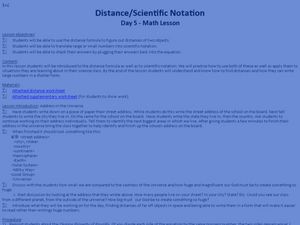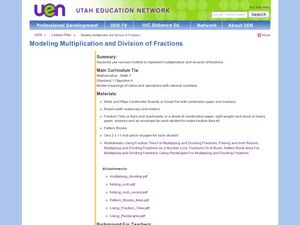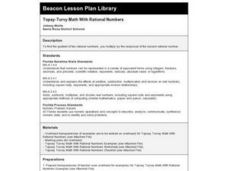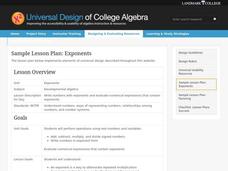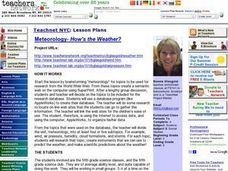Ohio Department of Education
Multiplying and Dividing in Scientific Notation - Grade 8
Here is really nice set of resources on scientific notation. Eighth and ninth graders explore the concept of multiplying and dividing in scientific notation. For this multiplying and dividing numbers in scientific notation...
Curated OER
Scientific Notation II: The Mantissa
Practice converting a conventional number into scientific notation, and vice-versa. Using an applet, they perform the operations of multiplication and division on numbers expressed in scientific notation.
Ohio Department of Education
Writing and Comparing Numbers in Scientific Notation-Grade Eight
Explore scientific notation in this mathematics lesson. Young mathematicians explore multiple representations of large number in scientific notation through the use of models, visual representation and expanded form. The lesson provided...
Willow Tree
Scientific Notation
Numbers that are very large or very small are difficult to express in standard notation. Pupils learn how to convert between standard and scientific notation. They also multiply and divide the numbers in scientific notation.
Curated OER
7th Grade Scientific Notation
Middle-school mathematicians identify the need for scientific notation. Learners convert large and small numbers into scientific notation. Students review the powers of ten and write them on the board in standard form and scientific...
EngageNY
Operations with Numbers in Scientific Notation
Demonstrate the use of scientific notation within word problems. The lesson presents problems with large numbers best represented with scientific notation. Pupils use these numbers to solve the problems in the 11th installment in a...
Curated OER
Scientific Notation
Students observe the teacher writing numbers and determine the rules for scientific notation. After explanations, they perform operations on numbers in scientific nation and discuss reasons for using this method of writing numbers and...
Curated OER
Scientific Notation II: The Mantissa
Students after completing the Part II (of 2) scientific notation online lab exercises, manipulate and interpret large numbers expressed in the "mantissa and exponent" format of scientific notation.
Curated OER
Scientific Notation I: The Exponent
Learners manipulate and interpret large numbers expressed in the "exponent" format of scientific notation.
Curated OER
WORKSHEET # 7 [4.1, 4.2, & 4.3], Exponent Review
For this algebra worksheet, students answer 37 multiple choice questions, each having to do with exponential operations. Twenty-five problems require students to multiply exponential terms. four problems involve dividing with exponents....
Curated OER
Distance, Scientific Notation
Students calculate the distance of two objects, and rewrite numbers using scientific notation. In this algebra lesson, students solve linear equations and plug the values back into the equations to check their answers. They write small...
Curated OER
Modeling Multiplication and Division of Fractions
Create models to demonstrate multiplication and division of fractions. Using fraction tiles to model fractions, pupils explore fractions on a ruler and use pattern blocks to multiply and divide. They also create number lines with fractions.
Virginia Department of Education
Exponents
Expand your knowledge of exponents with an activity that promotes critical thinking and comparison skills. Middle and high schoolers compare numbers written in expanded and exponential form and explain their strategies for solving...
Willow Tree
Multiplying and Dividing Monomials
Apply the power of mathematics to the power expressions. The lesson plan gives examples of expressions that utilize each of the exponent rules to simplify. Once seeing the exponent rules individually, scholars combine them to simplify an...
Curated OER
Solving a Legend- Exponents, Recursive and Explicit Equations.
Eighth graders play a game to solve problems. In this exponents and scientific notations lesson, 8th graders play a game in small groups to move colored disks from location A to location C. Students identify recursive patterns to solve...
Curated OER
Frequency Tables
Seventh graders construct frequency tables and box-and-whisker plots. After constructing tables and plots, they take a quiz on mean, median, mode, range, scientific notation, and number properties.
Illustrative Mathematics
How Many Cells Are in the Human Body?
Investigating the large numbers of science is the task in a simple but deep activity. Given a one-sentence problem set-up and some basic assumptions, the class sets off on an open-ended investigation that really gives some...
Curated OER
Hoe Long Does it Take to Get to a Star
Young scholars calculate the distance in light years. In this geometry lesson, students solve problems involving distance, using the distance formula. They rewrite big numbers using scientific notations and apply their knowledge of...
Curated OER
Simplify Expression Using the Order of Operations
Allow learners to explore both the right and wrong way of completing equations with the order of operations. They discuss how the order in which operations are performed affects the outcome of a problem. A fun "trick" using order of...
Curated OER
Worksheet Chapter 5 College Prep Algebra
In this algebra worksheet, students evaluate algebraic expressions, simplify exponents, write numbers in scientific notation, perform division of equations, and find the area of given problems. This worksheet contains 75 problems and an...
Curated OER
Topsy-Turvy Math With Rational Numbers
Fourth graders complete a worksheet. As a whole class, 4th graders hear a lecture and complete a worksheet on factors, multiplicative inverses and reciprocals, finding the quotient of two fractions and the division of fractions to...
Curated OER
Exponents
Ninth graders solve problems involving exponential functions. In this algebra lesson, 9th graders apply their knowledge of exponential properties to add, multiply, divide and subtract exponential functions. They perform these operations...
Curated OER
Science: How's the Weather?
Fifth graders brainstorm meteorological terms to create a semantic web using SuperPrint. For each topic, they create instruments, such as barometers or psychomotors, that they use to make scientific predictions about the weather. After...
Virginia Department of Education
Thermochemistry: Heat and Chemical Changes
What makes particles attract? Here, learners engage in multiple activities that fully describe colligative properties and allow the ability to critically assess the importance of these properties in daily life. Young chemists...
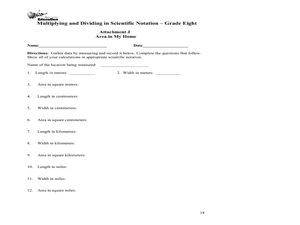
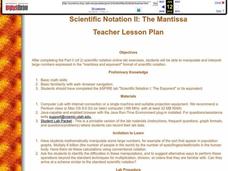
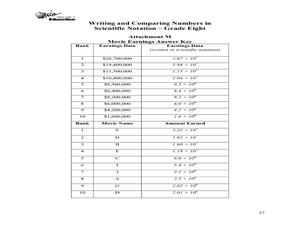





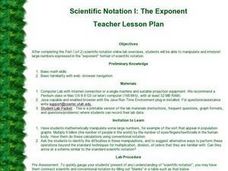
![WORKSHEET # 7 [4.1, 4.2, & 4.3], Exponent Review Lesson Plan WORKSHEET # 7 [4.1, 4.2, & 4.3], Exponent Review Lesson Plan](http://content.lessonplanet.com/resources/thumbnails/160773/large/cgrmlwnvbnzlcnqymdezmdmzmc05ntq0ltfuzgxmzgcuanbn.jpg?1414261468)
